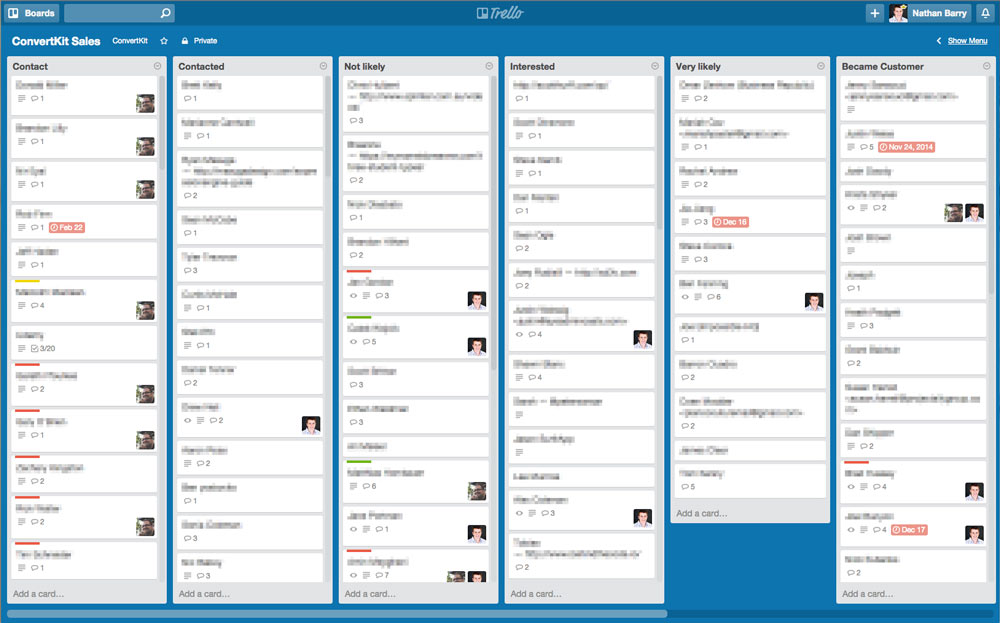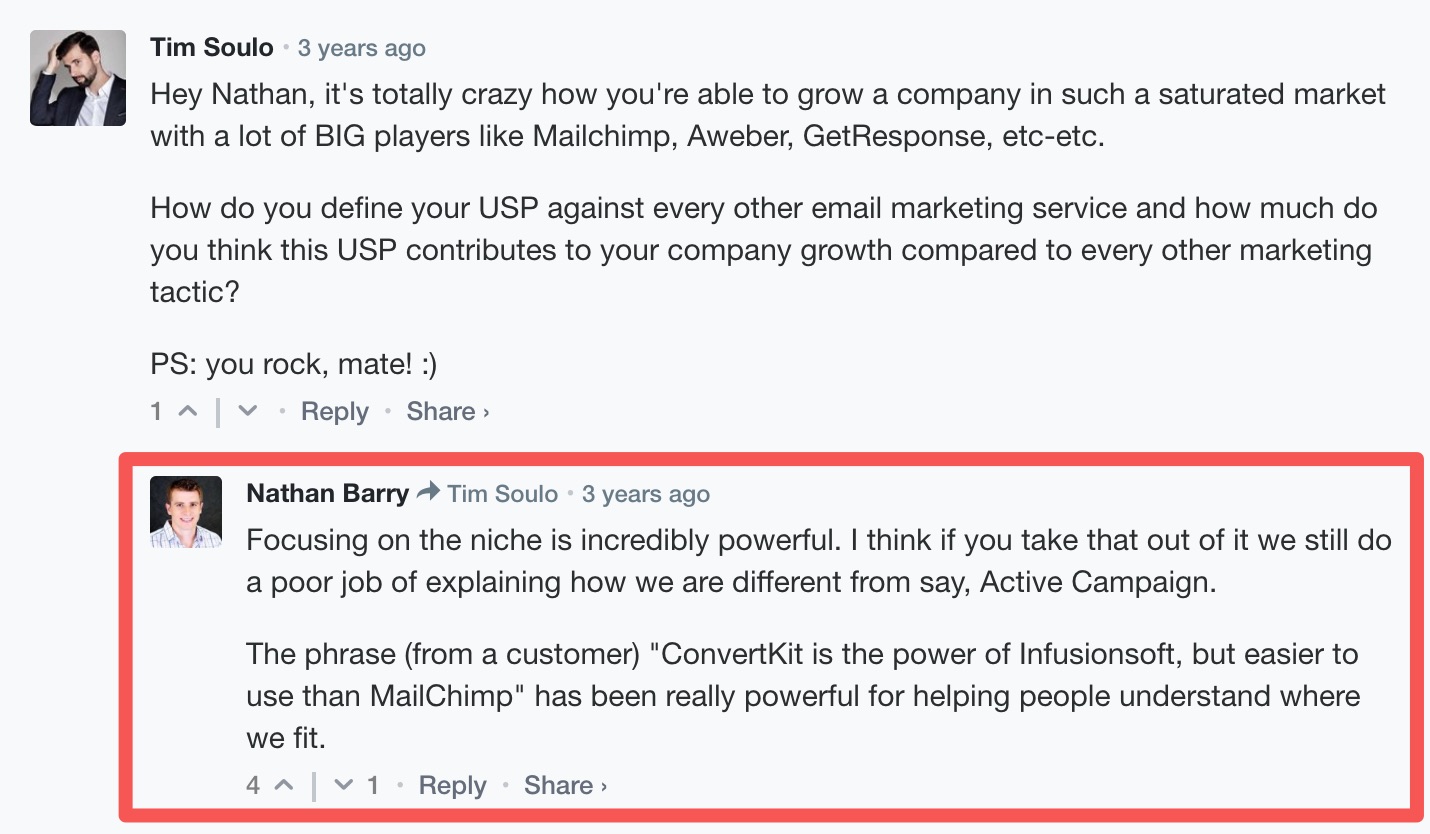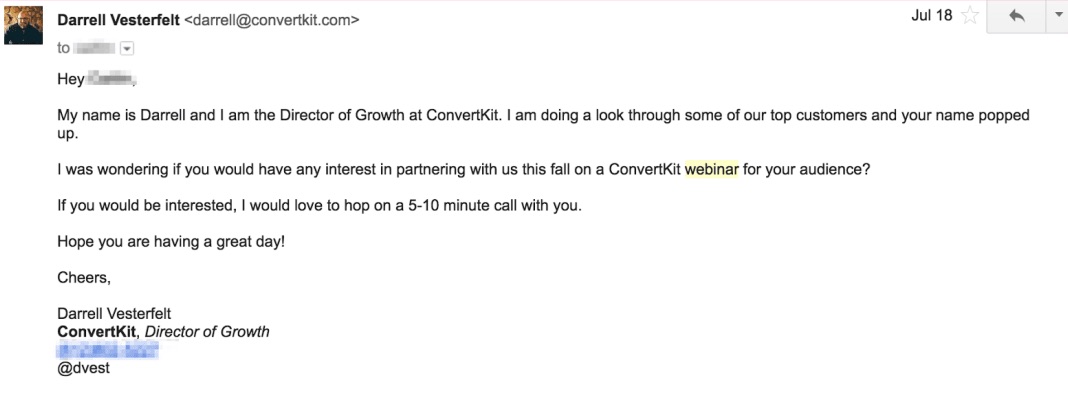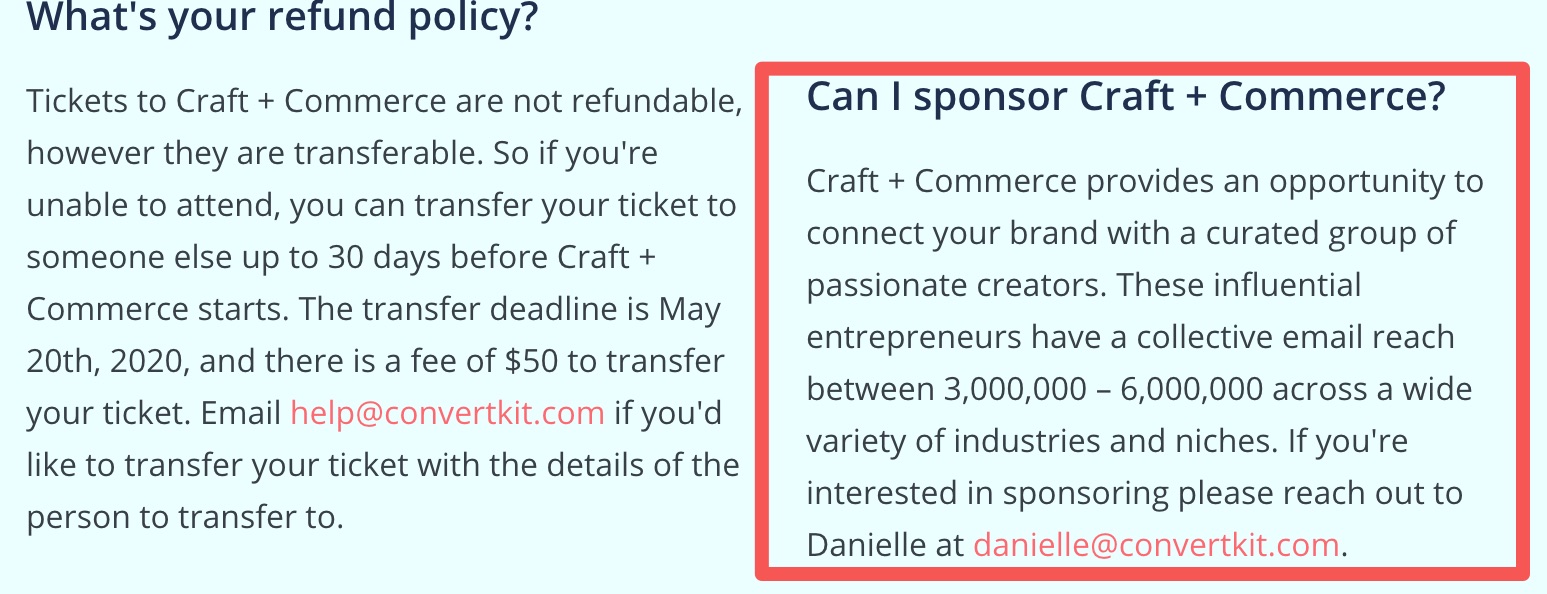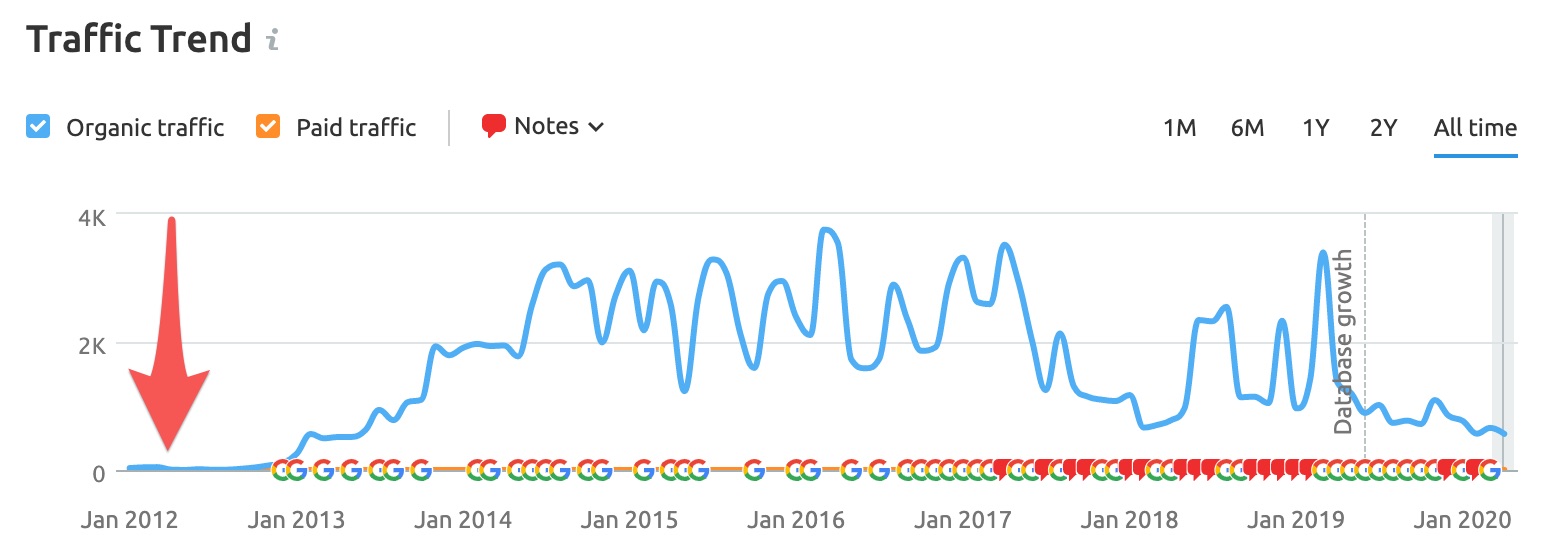It’s January 2013 in Boise Idaho and Nathan just set himself an ambitious goal.
He is going to invest $5k in building a SaaS web application and aims to grow it to $5k MRR in six months.
After six months of hard grind, Nathan lands on $2,480 MRR.
Surely growth would continue up to the $5k goal over the coming months to allow Nathan to hit the goal in maybe twelve months?
Unfortunately not, by October 2014, monthly revenue had slid down to $1,207.
In the end, it took 23 months and a further $50k investment for ConvertKit to reach $5k MRR.
But fast forward to May 2019, ConvertKit has sent 851,000,000 emails and enabled $273,482,000 in earnings for its 19,000 customers over the previous 12 months.
Today MRR is $1.7m – SaaS business growth at its absolute best.
How did he do it?
This post explains…
Growth Lever 1 – Cut All Other Options
Like many online entrepreneurs, Nathan thought he could do it all.
He set himself the challenge of starting a SaaS business whilst still writing books and delivering online courses – which was bringing in approximately $40,000 per month in revenue and netted Nathan $250,000 in 2013.
For the first few months of the challenge, everything was going fine: Nathan’s books and course were still selling and ConvertKit started to generate subscription revenue:
But as you can see, growth levelled off, declining from $2k to $1.3k per month:
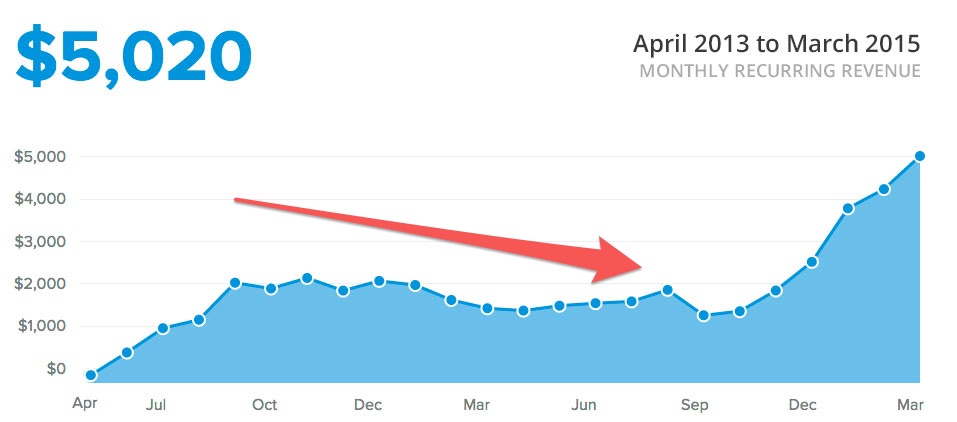
And it was only in late September of 2014 that Nathan was taking a walk at a marketing conference with Hiten Shah:
‘Look, you should shut down ConvertKit.’
Nathan thought this was good advice, but I think we can agree it isn’t nice advice for someone that had been working on something for almost eighteen months.
Hiten continues:
‘You’ll be successful in whatever you do, you’ve proven that with the books and courses, but ConvertKit’s not working. Shut it down, move on and don’t let it hold you back.’
Nathan was quiet, thinking about his options… then Hiten drops the bomb:
‘Or, you can take it seriously, give it the time, money and attention it deserves and build it into something real. But what you’re doing is not working, so either shut it down or double down.’
So in late September 2014, Nathan doubles down on ConvertKit:
And after three months of strong growth, he invests $50,000 of his savings into the business… and away we go.
LEARNING: SaaS businesses can start on the side, but to grow – they need full-time attention from their founders.
Growth Lever 2 – Developing The Necessary Skills
Now this doesn’t get talked about a lot…
But building a SaaS business is hard, and just like you wouldn’t expect to be able to play Mozart after practicing the piano for a few weeks… you shouldn’t expect to be able to bootstrap a SaaS business at your first attempt.
For the sake of this blog post, let’s say there are four levels of business complexity:
- Freelancing – you do the work for clients
- Agency – you have other people do the work for clients
- Books/Courses – you build information that can serve many customers
- SaaS – you build software that can serve many customers
Now each of these steps requires a greater number of more complex skills – skills that must be built over time:
- To freelance, you must have a skill that delivers value to a client
- To grow an agency, you must be able to hire and manage people
- To sell books and courses, you must know marketing and sales
- To build a SaaS business, you need all of the above and many more…
Nathan spent time in all of the areas above after starting out as a freelancer in 2007:
Developing these skills yourself also increases the likelihood that you will be able to bootstrap the business. In Nathan’s example, he only needed to hire a contract back end developer to build the ConvertKit MVP as he had the skills to design and code the front end – saving him tens of thousands of dollars.
You also get additional bonus points if you are able to develop these skills “as the customer of your future SaaS business”.
Allow me explain…
Whilst Nathan was writing eBooks, selling courses and doing work for clients, he was living the life of a potential ConvertKit customer. So when the time came to build and promote the SaaS product, he didn’t have to spend time learning the industry or persona’s.
In summary, it may seem that Nathan woke up one day and decided to build a SaaS product in a random industry and it worked out really well… but in reality, he started “building” ConvertKit on the day that he started in online entrepreneurship.
LEARNING: What are the skills that you or your cofounders can develop BEFORE embarking on the hard journey of building a SaaS business?
Growth Lever 3 – Embrace Your Inner Sales Person For SaaS Business Growth
As we know, by the time Nathan launched ConvertKit he had a number of years experience selling information in the form of books and courses.
You don’t get to those numbers without having a solid grasp of online marketing principles.
So what online marketing strategy did Nathan select to find ConvertKit’s first customers?
- Building an email list?
- Content marketing?
- Podcasting?
- Facebook Ads?
- Google Ads?
- Native Ads?
None of those.
He went door to door.
Well kind of…
He found ideal customers that were using either Mailchimp or Aweber and pitched them on switching to ConvertKit.
Here’s a sample of one of Nathan’s cold emails:
Sarah,
Is anything frustrating you with MailChimp?
The reason I ask is I run ConvertKit, which is an email marketing platform for professional bloggers. We’ve got a lot of great bloggers using us like Katie and Seth from Wellness Mama, Pat Flynn from Smart Passive Income, and Chris Guillebeau.
I’d love to hear more about how we can build it to better serve bloggers like you.
Talk soon,
Nathan
And here’s Nathan’s Trello board he used to track leads:
Remember – ConvertKit was originally built out of Nathan’s frustration with existing email autoresponders, so its early features exploited the weaknesses of these two platforms, making these sales conversations relatively straightforward.
When a prominent blogger based in New York City mentioned “we should meet for a coffee!” over email, Nathan took this seriously and flew over.
Why is Nathan doing this?
- He’s learning about his customers
- He’s building relationships with big customers (and soon to be affiliates, see Growth Lever X)
- He’s closing that early revenue without significant costs (his time is cheap at this stage of the business)
I mean, what else should a SaaS founder be doing at this early stage?
Finally what is Nathan’s response when asked whether this one to one sales method can scale?
If you can’t get customers, why does it matter if you can scale anyway?
LEARNING: Forget your blog, social channels and email list. Find a database of prospects and hit them one after another until you’re over $50k MRR.
Further Reading: SEMRush: The $100m Black Sheep Of SaaS
Growth Lever 4 – Narrow Your Niche
When bootstrapping, or even in the early days of a funded SaaS – you can’t serve everyone.
Remember this graph:
It’s September 2013, ConvertKit doesn’t have a full time founder and is currently positioned as “Email marketing for… everyone”.
By the start of October 2013, Nathan goes full time and niches down to “Email marketing for… authors”.
Why authors?
- Nathan has sold to this niche before with his book: Authority so had an in depth knowledge of the persona
- These people are easy to find on other platforms such as Udemy and Amazon
Combining this niche focus with Nathan having more time for his outbound sales strategy outlined in the previous Growth Lever led to 23% MRR growth in October:
And 27% MRR growth in November:
Despite helping ConvertKit almost double MRR in two months, Nathan started to notice a problem with “email marketing for authors” – these people were the small fish: hobbyists not professionals.
Someone who identified as an author didn’t have a big an email list as say… someone who called themselves a blogger.
Nathan spent a weekend up in the mountains of North Carolina with his mastermind group and after a ninety minute session on ConvertKit, he returns to the office and announces a position change:
He will now re-focus his direct sales outreach on professional bloggers with 30,000 to 250,000 email subscribers.
And revenue starts to grow:
But something else happens just before the sharp uptick you see:
One of the highest profile professional bloggers: Patt Flynn becomes a customer… and an affiliate (more on this in the next Growth Lever).
When asked about how ConvertKit were able to grow whilst in such a competitive market, Nathan shares that niching down was the key:
And how about ConvertKit’s position today?
Email marketing for online creators.
Why broaden the niche from “professional bloggers” when narrowing worked so well in the early days?
It’s simple.
Because they can.
ConvertKit now has the brand awareness and resources to take on and serve a larger market.
If ConvertKit had not chosen to niche down from “Email marketing for… everyone” I doubt I would be sat here writing this post.
In summary, ConvertKit has gone from:
- Email marketing for… everyone – MASSIVE niche
- Email marketing for authors – Small, target niche
- Email marketing for professional bloggers – Smaller, better suited niche
- Email marketing for creators – Larger niche
In fact, when we asked ConvertKit’s Director of Marketing & Data: Derrick Hicks, what he thought the number one most important factor that has lead to their growth…
He said:
“Our ability to solve problems for specific groups of creators“
The important phrase here is “specific groups”. You can’t get specific without niching down.
Here’s the full quote:
LEARNING: Niche down and focus on the group of customers that you serve best (and that serves you best)
Growth Lever 5 – Scaling Partner Webinars
It’s an age old strategy…
- Find other people that sell to the same people as you
- Pay them to send you customers
It’s just that ConvertKit worked directly with these partners to create live video content with them in the form of a webinar together. Adding value through content before getting to the pitch.
And it wasn’t just the big affiliates… any affiliate regardless of the “size of their list” was eligible for a co-hosted webinar with the ConvertKit team.
Here’s a template email that early ConvertKit marketer Darrell Vesterfelt would send to customers:
At one point, ConvertKit had 13,000 customers and 4,000 affiliates. As part of the onboarding process, all new customers were given the opportunity to become affiliates.
Remember the new positioning “email marketing for professional bloggers”?
A large chunk of this niche are also DREAM affiliates for ConvertKit.
Those bloggers that teach other bloggers, are currently communicating with their audience by email and will no doubt be happy to tell their audience about this if a 30% lifetime recurring commission is up for grabs.
Darrell then proceeded to execute a total of 150 of these webinars over a twelve month period.
This is impressive.
And I bet by webinar twenty, it was a honed, high converting machine.
They gave away a free trial to ConvertKit, one of Nathan’s books and an online course to people that stayed until the end:
Despite this, things didn’t really kick off until Pat Flynn became an affiliate:
Here’s a screenshot from one of Pat Flynn’s income reports a few months after he became an affiliate:
$21,551.84 in commissions meant that during that month, ConvertKit pulled in $71k revenue from Pat Flynn alone.
In summary, most people just tack on an affiliate program into the footer of their website and forget about it until a trickle of new customers come in.
ConvertKit made it a priority:
LEARNING: When you find a growth channel that works: go HARD.
Growth Lever 6 – Smooth Onboarding To Grow SaaS
Creating your ConvertKit account is a dreamy experience.
After clicking the sign up page on their homepage, you get sent right into a three part survey…
First we’re asked about whether we are starting out or moving from another tool:
If we state that we are moving from another tool, we are asked which one:
We are then asked about the amount of subscribers we will be bringing over:
Each step is armed with social proof to maximise throughput to the final stage.
This process is doing three things:
- It’s getting us in the mood to actually do things with ConvertKit’s software – increasing the likelihood we will use the tool and therefore reducing the likelihood that we will churn
- It’s giving ConvertKit the information they need to customise our product and customer service experience – again reducing the likelihood we will churn
- It’s gathering market and competitive intelligence for ConvertKit – allowing them to better serve the market through understanding which of their competitors is haemorrhaging the most customers
LEARNING: Consider building a smooth, data gathering, customer experience improving onboarding flow for your SaaS…
Growth Lever 7 – Conference For Connection
Why do SaaS businesses host conferences?
This is a question I have asked myself over and over again. When investigating why Outreach host their annual Unleash conference, I concluded here that they did it simply to get other people to pay for a party.
But with ConvertKit’s Craft & Commerce conference, things are a little different…
They don’t seem to be as concerned with sponsorship, it’s almost an afterthought in their FAQ’s
So why do it?
BRAND
To find out why, we asked Derrick Hicks, ConvertKit’s Director of Marketing and Data:
LEARNING: All tribes thrive when they come together in person – when is your next event?
Growth Lever 8 – Actually Living Brand & Values
When I scroll to the “values” section on the About Us pages on 99% of SaaS businesses: I cringe.
They are most likely:
- Incongruent
- Uninspiring
- Watered down
- Ignored internally
ConvertKit’s on the other hand:
Let’s take just one: Work In Public.
This post was incredibly easy to write as ConvertKit LIVE this value and do share their work in public:
- Nathan has been sharing insights from ConvertKit’s growth before ConvertKit even existing
- Derrick shared his audio insights with us almost instantly, without any lengthy sign-off from the PR team
- You can literally see all previous revenue trends on Baremetrics:
I think it’s safe to say that ConvertKit have embodied the Work In Public value.
Furthermore, you can tell that Nathan lives and breathes these values and the ConvertKit brand.
In this talk at the most recent Craft & Commerce conference, Nathan rally’s the troops by sharing the fact that all the other big players (ActiveCampaign, Mailchimp and Drip) have moved upstream to serve larger businesses… leaving just ConvertKit to serve the creators:
This quote is a beauty:
“Creators: they are using your money to go after bigger companies”
Every tribe needs a common enemy and Nathan very carefully and powerfully identified three of them in the first four minutes of this talk.
LEARNING: What are your brand values and have you truly internalised them?
Growth Lever 9 – The SaaS Growth Potential Of Freemium
In an unprecedented move on their seventh birthday, ConvertKit introduce a Freemium plan.
Yep for the first time ever, “creators” can now use a limited set of features without ever paying ConvertKit a dime.
Let’s understand why.
First of all, in the blog post detailing their rationale for this move, Nathan states that:
- Many creators start with Mailchimp and then graduate to ConvertKit as their business grows
- Previously, their cheapest plan ($29 per month) had the highest churn of all plans (12%) with users stating it was too expensive
So why not introduce freemium and serve these users from day one in the hope that their business grows with ConvertKit.
This is all well and good, and would be suitable rationale. But of course, ConvertKit have some interesting growth strategies tricks up their sleeve.
First, when on the free plan, you are not able to remove the “Powered By ConvertKit” branding from popups and landing pages. Exposing your site traffic to ConvertKit’s brand.
Second, from within the product if you click on either of the premium tabs, you are present with two options:
- Upgrade
- Refer a friend
A free user is able to refer a friend in order to unlock either the “Automation” or “Sequences”feature for 100 subscribers.
In summary, yes ConvertKit are serving the small segment of the creator market with their freemium offering, but they are also supercharging their growth.
And just in case we missed anything here, we asked Derrick if there had been an unexpected impacts of the switch to the freemium model:
LEARNING: If you go freemium, ensure that you “get paid” by your users in the form of exposure to the people they communicate with.
Growth Lever 10 – The Immaculate Conception
After spending the past week trying to understand how ConvertKit have been able to grow to $1.7m MRR with just $55k of funding I kept coming back to Nathan’s personal entrepreneurial journey.
Just as Satoshi Nakamoto’s actions led to Bitcoin’s immaculate conception, Nathan’s entrepreneurial career led to the immaculate conception of ConvertKit.
This means that Satoshi and Nathan had cultivated their skills for years prior to allowing their “baby” out into the wild.
To illustrate this, let’s take a look at what Nathan did BEFORE starting ConvertKit:
First, he got good a launching things
Before launching ConvertKit, Nathan launched or tried to launch:
- A hosting business
- A WordPress theme business
- A local social network for businesses
- An iPad app to help non verbal kids communicate
- A “flashcards” iPhone app
- A habit tracking iPhone app
- Two books
Though not all of these were “successful”, Nathan would have definitely developed skills he would have used when building and launching ConvertKit.
Then he developed some of the skills needed to build a web application
As per Nathan’s Linkedin, he spent a total of six years learning web and front end design prior to starting ConvertKit:
As mentioned above, this significantly reduced his upfront development costs when building ConvertKit’s MVP.
And then he built an audience and a network
Nathan released two books in the web design/online marketing space over the four years prior to launching ConvertKit, he also has been blogging on NathanBarry.com since 2012:
This helped when finding beta customers for ConvertKit’s first launch. He was also privy to the advice from experienced entrepreneurs during the process, notably Hiten Shah whose questioning convinced Nathan to focus on ConvertKit full time.
Without these three, I believe (and maybe Nathan does too) that I wouldn’t be here writing or you wouldn’t be here reading… this post.
LEARNING: What are the skills or assets you can build NOW that will lead to the immaculate conception of your SaaS business or next killer growth strategy?
What did we learn?
- SaaS business can start on the side, but to grow – they need full time attention from their founders.
- What are the skills that you or your cofounders can develop BEFORE embarking on the hard journey of building a SaaS business?
- Forget your blog, social channels and email list. Find a database of prospects and hit them one after another until you’re over $50k MRR.
- Niche down and focus on the group of customers that you serve best (and that serves you best)
- When you find a growth channel that works: go HARD.
- Consider building a smooth, data gathering, customer experience improving onboarding flow for your SaaS…
- All tribes thrive when they come together in person – when is your next event?
- What are your brand values and have you truly internalised them?
- If you go freemium, ensure that you “get paid” by your users in the form of exposure to the people they communicate with.
- What are the skills or assets you can build NOW that will lead to the immaculate conception of your SaaS business or next killer growth strategy?
Which was your favourite Growth Lever, please leave a comment on Twitter or on the post below…
We spent a week studying how @ConvertKit grew to $1.7m MRR with just $55k investment from founder @nathanbarry 📈
Here’s what I found 👇👇👇
— SaaS Marketer (@SaaS_Marketer) April 22, 2020
And be sure to add your email here to receive one of these case studies every two weeks.






